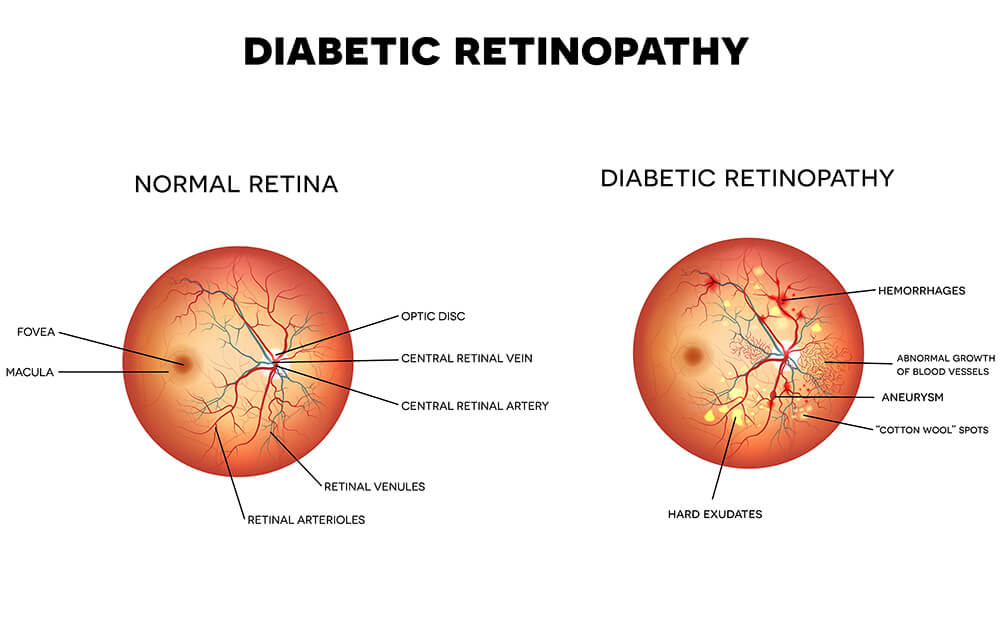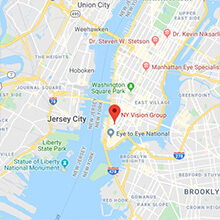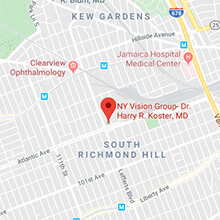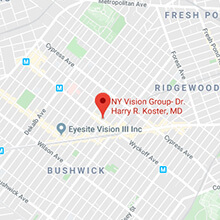People with diabetes face a group of eye problems as potential complications of their disease.
These complications include:
- Diabetic Retinopathy: Damage to the blood vessels of the retina;
- Cataracts: clouding of the eye’s lens—cataracts often develop at an earlier age in people with diabetes;
- Glaucoma: increase in fluid pressure inside the eye that leads to optic nerve damage and loss of vision. A person with diabetes is nearly twice as likely to get glaucoma as other adults.
All of these diabetic eye complications can cause severe vision loss or blindness. Consequently, it is essential that people with diabetes, both type I and II, get a comprehensive dilated eye exam at least once a year. At NY Vision Group, we utilize the latest in ophthalmic testing instruments to screen for diabetic eye disease.
What is Diabetic Retinopathy?
Diabetic Retinopathy is the most common diabetic eye disease. It is caused by changes to the blood vessels of the retina. In some cases blood vessels may swell and leak fluid, in other cases, abnormal new blood vessels grow on the surface of the eye. In either case, it interferes with the ability of the retina to function properly and usually affects both eyes. All people with diabetes, both type I and type II are at risk. In fact between 40 to 45 percent of Americans diagnosed with diabetes have some stage of diabetic retinopathy. The longer someone has diabetes, the more likely that he or she will develop diabetic retinopathy.

At NY Vision Group, we test visual acuity, perform thorough dilated eye exams and monitor eye pressure and optic nerves. Additionally, we document findings using fundus photography, fluorescein angiograms, and retinal thickness profiles to serve as baseline exams against any future changes. Patients who are diagnosed with diabetic retinopathy are referred to one of our retina specialists for the most appropriate treatments. Treatments include laser treatments and newer generation intraocular medications, which cause abnormal blood vessels to regress. In other more severe cases, a surgical procedure called a vitrectomy, along with laser treatments, may be necessary.
Retinal Laser Treatment
Lasers were first used to treat eye diseases in the early 1970s and have become the standard of care for previously untreatable disorders. For many patients, laser treatment can preserve or prevent vision loss if given in a timely fashion. The pure, highly concentrated beam of light energy from a laser can be precisely focused on the retina, selectively treating the desired area while leaving the surrounding tissues untouched.
Often patients do not know they have retinal conditions because their eyes may look and feel normal even while there is hemorrhaging and fluid leakage in the back of the eye. A patient’s sight may also be normal for a while despite the presence of potentially blinding eye problems. The only way to tell if a retinal treatment is necessary is to have a careful, dilated retinal examination, often followed by special testing including OCT scanning and fluorescein angiography (a photographic test that evaluates the eye’s circulation). At NY Vision Group, lasers are commonly used to treat the following eye conditions: diabetic retinopathy; retinal vein occlusions; retinal breaks and detachments and other retinal vascular disorders.
Retinal Vein Occlusions
The small blood vessels that drain blood from the retina (retinal veins) can sometimes become blocked as part of the aging process. This is more common in patients with diabetes or high blood pressure. A retinal vein occlusion can cause the retina to swell with fluid and blood, blurring central and peripheral vision. Other times, new blood vessels may grow and cause pain with very high pressure inside the eye (neovascular glaucoma). Laser treatment can help reduce this swelling or cause the new blood vessels to disappear.
Retinal Tears and Detachment
The retina lines the back of the eye like wallpaper. A retinal tear can occur as part of an aging phenomenon or following cataract surgery or eye injury. Often, patients will see cobweb-like floaters or light flashes when a retinal tear develops. The liquid that normally fills the central portion of the eye (the vitreous) can leak beneath the tear, lifting the retina away from the eyewall. This is called a retinal detachment, which can cause blindness if left untreated. Laser surgery around retinal tears is often able to weld the retina to the underlying eyewall. This can prevent or limit retinal detachment.
Other Retinal Vascular Disorders
CRVO, BRVO, and retinal macroaneruysms are among multiple retinal vascular disorders that in certain instances are treated with laser. The laser can help repair damage and prevent blindness and, along with other modalities, remains a useful adjunct in managing the retinal disease.
How Do Laser Treatments Work?
There are no special preparations before eye laser treatment. Patients should eat normally and take their regularly prescribed medications before surgery. Retinal laser surgery is typically performed in our state-of-the-art offices. Eye drops will be given to dilate the pupil and numb the eye. The treatment is performed while you are seated in a chair, similar to the one used for regular eye examinations. You will remain awake and comfortable. Treatment is usually painless. The laser treatment usually takes less than 30 minutes to complete, and you can go home immediately following surgery.
Restrictions and Side Effects
There are virtually no restrictions following retinal laser surgery, and you should be able to resume your normal activities and work schedule the following day. Most patients notice no vision changes following their laser surgery, although there may be some temporary blurring for several weeks to months. In addition, depending on the condition being treated, some may notice a permanent blind spot or decrease in peripheral and night vision. It will take several weeks to months before we can tell whether the laser treatment has been successful and patients may need more than one treatment to control their eye problem and prevent further loss of vision. Prior to the treatment, your doctor at NY Vision Group will discuss the risks, benefits, and alternatives of the procedure so you can decide if it is right for you.




